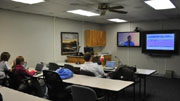VOA标准英语2011--Rural Medical School Keeps Doctors in Small Towns(在线收听)
Rural Medical School Keeps Doctors in Small Towns
For the first time in modern history, more people are now living in cities than in rural areas. That includes doctors, leaving many small communities with no primary care physician. However, a new program at Kansas University may change that.
“We need more doctors. A quarter of all of our physicians in Kansas are 60 years or older. So we need to be replacing physicians too,” says Dr. William Cathcart-Rake, who directs a new program at Kansas University which is designed to provide those physicians.
The idea is to get medical school students to practice in rural Kansas by educating them in the state’s smaller communities.
According to Cathcart-Rake, students from rural areas typically go off to medical schools in Wichita and Kansas City.
“They say they have every intention of coming back to rural Kansas but they meet a soul mate, they get married. Their soul mate happens to be from a big city and we never see them agai. They get captured in the big city," he says. "Hopefully, if we train them in smaller communities, they can meet their prospective spouses here, they can network here and they have those connections which can be lifelong.”
 |
| Medical students in the small town of Salina - population 50,000 - listen to a remote lecture. It's part of a Kansas University program designed to keep doctors in rural areas of the United States. |
The program is based in the small town of Salina - population 50,000 - which is about a three-hour drive from Kansas City, past corn and soybean fields and the occasional cattle ranch. The medical school in downtown Salina is housed in a three-story brick building which was refurbished specifically for the program.
The first thing you notice is that the professor is not in the room. Instead, he appears on a flat-screen monitor at the front of the classroom.
“It's set up with interactive TV, so we have two monitors. On one, we see the lecturer's slides, and on the other monitor, we see video of the lecturer,” says Claire Hinrichsen, a student in the Salina program. “Most of our lecturers are out of Kansas City. Today, our lecturer was in Wichita.”
The professor in Wichita also has a video feed of the Salina classroom. When students have a question, they raise their hand and speak into the microphone built into their desk.
Hinrichsen grew up in Lecompton, Kansas, a town of about 600 people. One of the reasons she chose the Salina program is because of the size of the class. There are only eight students, making it the smallest medical school in the country.
“I really like it. I know everybody in my class," she says. "We are close and it's a nice feeling. It goes back to when I went to KU (Kansas University), so I went to a big school, and I'm getting back to the small feel.”
Other classes are taught by professors in Salina, and students will get hands-on training throughout the four-year program. Then each one will go on to a residency in a small community in the surrounding area.
Dr. Kerry Murphy is a family physician at the Clay Center Clinic, about 100 kilometers northeast of Salina. Chances are at least one of the eight students in the program will do a residency here.
“This is a clinic that has currently eight doctors and four mid-level practitioners and we cover this town, but we also have satellite clinics in two nearby towns," Murphy says. "We operate as what I call a cradle-to- grave operation, we deliver babies and go up to doing nursing home care.”
It's unlikely that there will ever be enough primary care physicians for every small town to have its own doctor. Cathcart-Rake expects several doctors will work out of a central clinic, like Clay Center, and see patients at satellite clinics spread out around the county, like spokes of a wheel.
“Clay Center is a great model for what I foresee as what a primary care center in Kansas might be,” he says.
At the end of their residency, the students will have spent six years in rural communities in Kansas. Cathcart-Rake hopes that will be enough time for them to put down roots.
“And it's gonna hopefully harder for them to break away from those roots and go to bigger cities.”
One thing that could lure them away is money. Rural doctors typically serve older, poorer patients and going into a specialty practice in a big city tends to be far more lucrative. And with the high cost of medical school, it's difficult for graduates to turn down those opportunities. So the Salina program is offering extra financial incentives to help them resist.
“It's called the KMS, the medical student repayment program,” says Claire Hinrichsen, one of the five medical students who signed up for it. “For every year you give back to a rural area they pay for all our tuition.”
That means, if they practice in an underserved county for four years, they will have essentially gotten their medical degree for free. But, Cathcart-Rake says there’s a catch.
“If they don't practice primary care in an under-served area, they have to pay that back, with interest. So they have got those hooks in them. We hope this innovative program will keep students close to their roots. But only time will tell.”